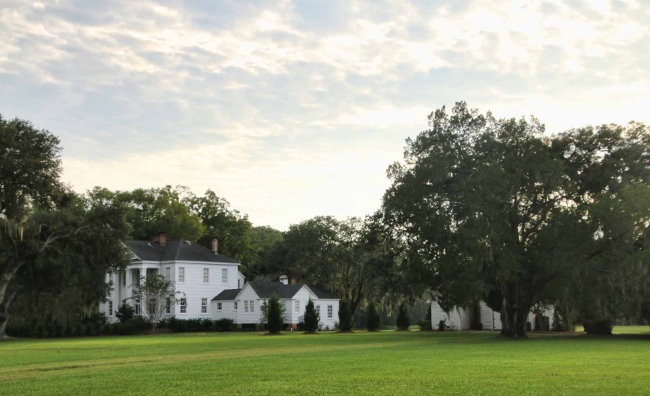Hope Plantation – Jacksonboro – Colleton County
Basic Information
- Location – Edisto River, Jacksonboro, St. Bartholomew's Parish, ACE Basin, Colleton County
- Comments – When Northrup R. Knox purchased Hope in 1956, the properties included in the tract were Ashe Plantation, Buzzard Island, Cattell Island, Newton Plantation, Old Hope Planation, Pringle Field Plantation, Rotterdam Plantation, and West Bank Plantation, plus the previously-combined properties of Baynard Plantation and Hywassee Plantation (1, p. 256).
- Origin of name – ?
- Other names – It was called Rice Hope Plantation by the Bischoff family (1, p. 255).
- Current status – Privately owned
Timeline
- 1799 – Earliest known date of existence
Lewis Morris purchased 1,700 acres from the estate of Sabrina and Daniel Huger. He soon added more land, bringing the total to 2,200 acres. Morris developed this land into Hope Plantation (1, p. 253).
- ? – House built
- 1824 – Morris died leaving his entire estate to his wife, Ann Elliott Morris (1, p. 254).
- 1843 – The Morris family was having a difficult time farming the land at Hope Plantation. This is evident in a letter Anna Morris received from her uncle E. VanderHorst in December of 1843 (4).
– Transcript; Original page 1 | page 2
- 1845 – The farming conditions had not improved at Hope Plantation. Anna sought advise from her uncle E. VanderHorst on selling some of the slaves (4).
– Transcript; Original page 1 | page 2
- 1848 – Ann Elliott Morris's will was probated; it was directed that her estate be divided equally into eight portions for her surviving children and trustees of her orphaned grandchildren (1, p. 255).
- 1849 – Hope Plantation was sold to Edward Barnwell of neighboring Prospect Hill Plantation to settle Ann Elliott Morris's estate (1, p. 255).
- 1865 – The house burned by the Union Army (1, p. 255).
- 1872 – House rebuilt
- 1874 – Barnwell sold Hope Plantation to Henry Bischoff. Bischoff also purchased the neighboring properties of Baynard Plantation and Hywassee Plantation. He combined all the properties into one which he then called Rice Hope Plantation (1, p. 255).
- 1878 – Henry Bischoff died but his heirs continued to plant rice at the plantation (1, p. 255).
- 1893 – In August, a hurricane devastated the plantation (1, p. 255).
- 1918 – The Bischoff family sold Rice Hope to the Pon Pon Realty Company (1, p. 255).
- 1928 – Z. Marshall Crane purchased the plantation to be used as a winter home and hunting preserve (1, p. 255). It consisted of about 3,000 acres at the time of purchase. Crane called the plantation by its traditional name, Hope Plantation (2, p. 211).
Crane had a two-story Greek revival house built (1, p. 255). He had the existing house demolished as well as about 300 slave cabins (2, p. 211).
- 1939 – Max C. Fleishman purchased the plantation (2, p. 212).
- ? – P. O. Mead was the property's next owner (1, p. 256).
- ? – Ashepoo River Lumber Company then owned the plantation (1, p. 256).
- ? – Hope was owned by a group of people including Stiles M. Harper (1, p. 256).
- 1956 – Northrup R. Knox purchased the plantation, which then totaled roughly 5,000 acres. At the time of purchase, properties included in the tract were Ashe Plantation, Buzzard Island, Cattell Island, Newton Plantation, Old Hope Planation, Pringle Field Plantation, Rotterdam Plantation, and West Bank Plantation plus the previously-combined properties of Baynard Plantation and Hywassee Plantation (1, p. 256 and (2, p. 212).
- 1978 – Ted Turner purchased Hope Plantation from Knox (1, p. 256 and 2, p. 212).
- 2007 – Ted Turner still owned the plantation (3).
- 2014 – Ted Turner sold Hope Plantation for $15 million to a company affiliated with Spartanburg businessman George Dean Johnson. Johnson also owns neighboring Pon Pon Plantation (previously called Bluff-Wayne Plantation) (5).
Land
- Number of acres – 1,700 in 1799; 2,200 in early 1800s (1, p. 253); about 3,000 in 1928; about 5,000 in 1956; approximately 4,200 in 2014 (2, p. 211-212) (5).
- Primary crop – Rice (1, p. 255).
Slaves
- Number of slaves – ?
- Due to poor farming conditions, 90 slaves were sold in 1845 (4).
– Original bill of sale page 1 | page 2
- An additional 33 slaves were sold in January 1850 (4).
– Transcript; Original page 1 | page 2
Buildings
- The current house is a two-story Greek revival built in the late 1920s. During the same period as the construction of this house, an earlier house and about 300 slave cabins were torn down (2, p. 211).
References & Resources
- Suzanne Cameron Linder, Historical Atlas of the Rice Plantations of the ACE River Basin - 1860
(Columbia, SC: South Carolina Department of Archives and History, 1995), pp. 251-256.
 Order Historical Atlas of the Rice Plantations of the ACE River Basin - 1860
Order Historical Atlas of the Rice Plantations of the ACE River Basin - 1860
- Robert B. Cuthbert and Stephen G. Hoffius, editors, Northern Money, Southern Land: The Lowcountry Plantation Sketches of Chlotilde R. Martin
(Columbia, SC: The University of South Carolina Press, 2009), pp. 209-212
- Nate Jenkins, Turner Land Stirs Rumors (Charleston, SC: The Post and Courier, 2007)
- Information contributed by Kathy Nienhouse.
- Jason Ryan, So You Want to Own a S.C. Plantation? (Columbia, SC: The State, July 12, 2014)



